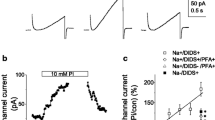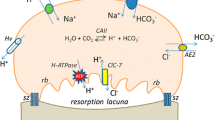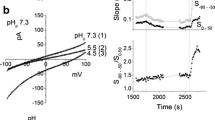Summary
Regulation of the acidity of osteoclasts was determinedin situ on the endocranial surfaces of mouse calvaria using acridine orange, a fluorescent weak base. Osteoclasts could be identified by (1) large size, (2) multiple nuclei, (3) relatively small numbers of cells, and (4) the way and the extent to which they took up the dye. Nonosteoclastic cells were stained mainly in their nuclei and occasionally in a few lysosomes surrounding their nuclei, which were uniformly single in nonosteoclasts. Nuclei in osteoclasts were also stained, but the staining of the nuclei was partially masked by the intensity and completeness of the staining of the cytoplasm. In some cells the cytoplasmic staining appeared to be in discrete granules, giving the cytoplasm a bright, frothy appearance. This fluorescence was present in both treated and untreated cells and aided in identifying the osteoclasts. Acridine orange fluorescence at 624 nm intensity, and hence, osteoclast acidity, was increased by parathyroid hormone and prostaglandin E2. Parathyroid hormone-induced increases in acidity were inhibited by calcitonin, cortisol, sodium fluoride, and prostaglandin E2. Furthermore, osteoclast acidity was dependent largely or partially on (1) maintenance of K+ and Na+ gradients, (2) patent Na+ channels, (3) chloride-bicarbonate exchange, and (4) H+, K+-ATPase. These findings demonstrate that osteoclasts become acidified by mechanisms similar to those occurring in gastric parietal cells.
Similar content being viewed by others
References
Vaes G (1980) Collagenase, lysosomes, and osteoclastic bone resorption. In: Wooley DF, Evans JM (eds) Collagenase in normal and pathological connective tissue. John Wiley and Sons, New York
Krieger WS, Tashjian AH Jr (1980) Parathyroid hormone stimulates bone resorption via a Na+−Ca+ exchange mechanism. Nature 287:843–845
Minkin C, Jennings JM (1972) Carbonic anhydrase and bone resorption: sulfonamide inhibition of bone resorption in organ culture. Science 176:1031–1033
Anderson RE, Jee WSS, Woodbury DM (1985) Stimulation of carbonic anhydrase in osteoclasts by parathyroid hormone. Calcif Tissue Int 37:646–650
Dell'Antone P, Colona R, Azzone GF (1976) The membrane structure studied with cationic dyes. Eur J Biochem 24:553–565
Rabon E, Chang H, Sachs G (1978) Quantitation of hydrogen ion and potential gradients in gastric plasma membrane vesicles. Biochem 17:3345–3353
Sachs G, Jackson RJ, Rabon EC (1980) Use of plasma membrane vesicles. Am J Physiol 238:G151-G164
Berglindh T, DiBona DR, Ito S, Sachs G (1980a) Probes of parietal cell function. Am J Physiol 238:G165-G176
Chew CS, Hersey SJ, Sachs G, Berglindh T (1980) Histamine responsiveness of isolated gastric glands. Am J Physiol 238:G312-G320
Soll AH (1980) Secretagogue stimulation of14C-aminopyrine accumulation by isolated canine parietal cells. Am J Physiol 238:G366-G375
DiBona DR, Ito S, Berglindh T, Sachs G (1979) Cellular site of gastric acid secretion. Proc Nat'l Acad Sci 76:6689–6693
Berglindh T, DiBona DR, Ito S, Sachs G (1980b) ATP dependence of H+ secretion. J Cell Biol 85:394–401
Baron R, Neff L, Louvard D, Courtoy PJ (1985) Cell-mediated extracellular acidification and bone resorption: evidence for a low pH in resorbing lacunae and localization of a 100-kD lysosomal membrane protein at the osteoclast ruffled border. J Cell Biol 101:2210–2222
Raisz LG (1970) Bone formation and resorption in tissue culture. Arch Intern Med 126:887–890
Raisz LG, Trummel CL, Wener JA, Simmons H (1972) Effects of glucocorticoids on bone resorption in tissue culture. Endocrinol 90:961–967
Dietrich JW, Goodson JM, Raisz LG (1975) Stimulation of bone resorption by various prostaglandins. Prostaglandins 10:231–240
Stern PH, Krieger NS (1983) Comparison of fetal rat limb bones and neonatal mouse calvaria: effects of parathyroid hormone and 1,25-dihydroxyvitamin D3. Calcif Tissue Int 35:172–176
Pressman BC (1976) Biological applications of ionophores. In: Annual review of biochemistry, Vol 45 (Annual Reviews, Inc. Palo Alto, CA) pp 501–526
Lund T, Cederberg C, Ekenved G, Haglund V, Olbe L (1983) Effect of omeprazole—a gastric proton pump inhibitor—on pentagastrin-stimulated acid secretion in man. Gut 24:270–276
Holtrop ME, Raisz LG (1979) Comparison of the effects of 1,25-dihydroxycholecalciferol, prostaglandin E2, and osteoclast-activation factor with parathyroid hormone on the ultrastructure of osteoclasts on cultured long bones of fetal rats. Calcif Tissue Int 29:201–205
Lucht U (1973) Effects of calcitonin on osteoclasts in vivo. An ultrastructural and histochemical study. Z Zellforsch 145:75–87
Yonaga T, Morimoto S (1979) A calcitonin-like action of prostaglandin E1. Prostaglandins 17:801–819
Chambers TJ, McSheehy PMJ, Thomson BM, Fuller K (1985) The effect of calcium-regulating hormones and prostaglandins on bone resorption by osteoclasts disaggregated from neonatal rabbit bones. Endocrinol 116:234–239
Anderson RE, Gay CV, Schraer H (1982) Carbonic anhydrase localization by light and electron microscopy: a comparison of methods. J Histochem Cytochem 30:1135–1145
Janowitz HD, Colcher H, Hollander F (1952) Inhibition of gastric secretion in dogs by carbonic anhydrase inhibitor 2-acetylamino-1,3,4-thiadiazole-5-sulfonamide. Am J Physiol 171:325
Gay CV, Mueller WJ (1974) Carbonic anhydrase and osteoclasts: localization by labeled inhibitor autoradiography. Science 183:432–434
Stern PH (1969) Inhibition by steroids of parathyroid hormone-induced Ca45 release-from embryonic rat bone in vitro. J Pharmacol Exp Ther 168:211–217
Klein DC, Raisz LG (1970) Prostaglandins: stimulation of bone resorption in tissue culture. Endocrinol 86:1436–1440
Madsen KM, Tisher CC (1985) Structure-function relationships in H+-secreting epithelia. Fed Proc 44:2704–2709
Author information
Authors and Affiliations
Rights and permissions
About this article
Cite this article
Anderson, R.E., Woodbury, D.M. & Jee, W.S.S. Humoral and ionic regulation of osteoclast acidity. Calcif Tissue Int 39, 252–258 (1986). https://doi.org/10.1007/BF02555214
Received:
Revised:
Issue Date:
DOI: https://doi.org/10.1007/BF02555214




